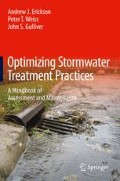Abstract
Stormwater treatment practices may reduce runoff volumes, contaminant concentrations, and/or the total contaminant mass load carried by runoff into receiving water bodies. Processes used by treatment practices include physical processes such as sedimentation, filtration, and infiltration, along with thermal, biological, and chemical processes. A single treatment practice may use multiple processes.
This chapter discusses these processes in detail and presents a brief discussion of how to assess the performance or current condition of each process within a treatment practice.
Access this chapter
Tax calculation will be finalised at checkout
Purchases are for personal use only
References
Arias CA, Del Bubba M, Brix H (2001) Phosphorus removal by sands for use as media in subsurface flow constructed reed beds. Water Res 35:1159–1168
Erickson AJ, Gulliver JS, Weiss PT (2007) Enhanced sand filtration for storm water phosphorus removal. J Environ Eng 133(5):485–497
Erickson AJ, Gulliver JS, Weiss PT (2012) Capturing phosphates with iron enhanced sand filtration. Water Res 46(9):3032–3042
Fang F, Brezonik PL, Mulla DJ, Hatch LK (2002) Estimating runoff phosphorus loss from calcareous soils in the Minnesota River basin. J Environ Qual 31:1918–1929
Ferguson RI, Church M (2004) A simple universal equation for grain settling velocity. J Sediment Res 74(6):155–160
Harper HH, JL Herr (1993) Treatment efficiencies of detention with filtration systems. SJRWMD Contract No. 90B103
Herb WR, O Mohseni, HG Stefan (2007b) A model for mitigation of surface runoff temperatures by a wetland basin and a wetland complex, Project Report no. 496, St. Anthony Falls Laboratory, University of Minnesota
Herb WR, Janke B, Mohseni O, Stefan HG (2009) Simulation of temperature mitigation by a stormwater detention pond. J Am Water Resour Assoc 45(5):1164–1178
Herrera Environmental Consultants (1995) Lake Sammammish phase 2 restoration project, Lake Park storm water treatment facility, task 2: bench scale test results
Kadlec RH, Knight RL (1996) Treatment wetlands. Lewis Publishers, Boca Raton
Klatt JG, Mallarino AP, Downing AJ, Kopaska JA, Wittry DJ (2003) Soil phosphorus, management practices and their relationship to phosphorus delivery in the Iowa Clear Lake watershed. J Environ Qual 32:2140–2149
Landers DH (1982) Effects of naturally senescing aquatic macrophytes on nutrient chemistry and chlorophyll a of surrounding waters. Limnol Oceanogr 27:428–439
McDowell RW, Sharpley AA, Beegle DB, Weld JL (2001) Comparing phosphorus management strategies at a watershed scale. J Soil Water Conservat 56:306–315
Metcalf and Eddy, Inc. (1991) Wastewater engineering: treatment, disposal, and reuse. McGraw -Hill, New York
Polta RC (2001) Fate and environmental impacts of sediments removed from stormwater ponds: a review. Environmental Services Division, Metropolitan Council, St. Paul
Polta RC, Balogh S, Craft-Reardon A (2006) Characterization of stormwater pond sediments. Met Council, St. Paul
Pote DH, Danial TC, Nichols AN, Moore PA, Miller DM, Edwards DR (1999) Relationship between phosphorus levels in three ultisols and phosphorus concentrations in runoff. J Environ Qual 28:170–175
Robertson WD, Schiff SL, Ptacek CJ (1998) Review of phosphate mobility and persistence in 10 septic system plumes. Ground Water 36:1000–1010
Schueler T (1992) Design of wetland stormwater systems: guidelines for creating diverse and effective wetlands in the Mid-Atlantic region. Metropolitan Washington Council of Governments, Washington
Stokes GG (1851) Transactions of the Cambridge Philosophical Society 9 (Part II), 8
Thomann RV, Mueller JA (1987) Principles of surface water quality modeling and control. Harper-Collins, New York
Weiss PT, G LeFevre, JS Gulliver (2008) “Contamination of soil and groundwater due to stormwater infiltration practices.” SAFL Project Report No. 515, St. Anthony Falls Lab, Minneapolis, MN
Zang GL, Burghardt W, Lu Y, Gong ZT (2001) Phosphorus-enriched soils of urban and suburban Nanjing and their effect on groundwater phosphorus. J Plant Nutr Soil Sci 164:295–301
Zvomuya F, Gupta SC, Rosen CJ (2005) Phosphorus leaching in sandy outwash soils following potato-processing wastewater application. J Environ Qual 34:1277–1285
Morgan, J.G. 2011. Sorption and Release of Dissolved Pollutants Via Bioretention Media. M.S. Thesis. University of Minnesota
Essington, M.E. (2004). Soil and Water Chemistry (First ed.). Boca Raton, FL: CRC Press
Dufour, A. 1984. Health Effects Criteria for Fresh Recreational Waters. EPA-600/1–84–004. Health Effects Research Laboratory, Office of Research and Development, U.S. Environmental Protection Agency, Cincinnati, OH
Grimes, S.M., G.H. Taylor, and J. Cooper. 1999. The Availability and Binding in Compost derived from Household Waste. Journal of Chemical Technology and Biotechnology, 74, 1125–1130
Davis, A.P., M. Shokouhian, H. Sharma, and C. Minami. 2001. Laboratory Study of Biological Retention for Urban Storm Water Management. Water Environment Research 73 (5), 73–82
Harmita, H., K.G. Karthikeyen, and Pan Xue Jun. 2009. Copper and Cadmiuum Sorption onto Kraft and Organosolv Lignins. Bioresource Technology, 100, 6183–6191
Essington, M.E. (2004). Soil and Water Chemistry (First ed.). Boca Raton, FL: CRC Press
Elliott, H.A., M.R. Liberati, and C.P. Huang. 1986. Competitive Adsorption of Heavy Metals by Soils. Journal of Environmental Quality, 15(3), 214–219
Author information
Authors and Affiliations
Rights and permissions
Copyright information
© 2013 Springer Science+Business Media New York
About this chapter
Cite this chapter
Erickson, A.J., Weiss, P.T., Gulliver, J.S. (2013). Stormwater Treatment Processes. In: Optimizing Stormwater Treatment Practices. Springer, New York, NY. https://doi.org/10.1007/978-1-4614-4624-8_3
Download citation
DOI: https://doi.org/10.1007/978-1-4614-4624-8_3
Published:
Publisher Name: Springer, New York, NY
Print ISBN: 978-1-4614-4623-1
Online ISBN: 978-1-4614-4624-8
eBook Packages: EngineeringEngineering (R0)

